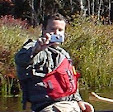"The Bell WildFire was conceived as a hull that would turn like the Yost designed DragonFly in moving/mild whitewater without being as tender. DragonFly was a race boat; 28.5 wide with a round bottom. Fast and maneuverable, it intimidated most intermediate and many advanced paddlers.
So WildFire, code named
"Bubba Bug" during development, was shorter, wider and had an
elliptical bottom compared to DragonFly's round one. Rocker was increased from
2", both stems to 2.5, both stems.
The project was a huge
success, selling over 100 boats a year for a decade, but that stern rocker
limited WildFire's sales to advanced paddlers. Anyone carrying their blade aft of
their body, or keeping their top hand inside the rail, or directing their
forward stroke along the rail instead of parallel to the keel would see
all four corners of the waterway.
Interestingly, WildFire
and FlashFire were designed to shoulders of the paddler-size bell curve.
Fifteen years later, WildFire is at the center of the bell curve, and we need
another boat to fit larger paddlers.
When we spec’ed the royalex version, we reduced the stern rocker from 2.5" to 1.5" to improve
tracking, assuming that the lower price would attract entry-level paddlers.
The stems got blunter
because royalex cannot be molded as tightly as composite materials. The shoulder got
softer because the thing needed to come out of a vacuum-forming mold. Charlie
Thompson made a multiple piece mold.
So heeling a royalex Yellowstone Solo to the rail doesn't lift the stems as high as can be done in a
composite WildFire.
Many builders, when they
decide to do a royalex version of a hull make a heavy glass boat, fill the stems
with stiff foam and start in with a belt sander to arrive at ~ 1" radiused
stems as compared to 1/4" radius on the original. This is one of two
reasons that royalex hulls tend to be shorter than their composite precursors. Royalex shrinkage is the second.
So yes, with a paddler
aboard to pooch out the bottom, royalex boats often turn faster than their composite
version because they are usually shorter at waterline. Again, due to both skin
friction and shorter waterline, royalex hulls are usually slower than their
composite versions and usually do not track as well.
Mr Yost does no such
thing; he starts with a straight line down the center of a long piece of paper,
but he still has to live with the blunt stems and softened contours endemic to
the royalex medium.
Excepting stern rocker,
Yellowstone Solo approximates WildFire's performance more closely than most royalex variants
do their composite versions."
And the later composite Yellowstone Solo:
"WildFire was commissioned by me from David Yost as a 14-foot symmetrical hull with 2.5" symmetrical rocker at the stems and asymmetrical shear line in 1993. A stripper was tooled, a split mold was made. That mold, now flanged for vacuum infusion, resides in Colden NY.
In 1999 Bell decided to enter the ABS vacuum formed market. The WildFire sized boat was redesigned with lower shoulders and blunter stems to accommodate the thick ABS sandwich and was spec'ed with less stern rocker to improve tracking for what was assumed to be an entry-intermediate level paddlers.
ABS vacuum forming molds are very different from composite molds. They are much thicker and have vacuum ducting and vents connecting to a significant vacuum plenum.
When Ted and I tore the blanket, The WildFire name and mold came East, Ted changed the newer hull's name to Yellowstone Solo, and requested a composite plug from DY, which was tooled and a two piece composite mold made. The composite stripper has sharper shoulders and tighter stems than are possible in ABS but retains the tripping differential rocker of the ABS hull. When DY draws asymmetrical rocker, he claims the hull comes out slightly swede form, so both Yellowstone Solos are probably also slightly swede form.
There are two Yellowstone Solos, the ABS and the composite. First year ABS Yellowstone Solos may carry a WildFire name plate. No composite Yellowstone Solos carry a WildFire nameplate."
Pictures of the WildFire and Yellowstone Solo
And the later composite Yellowstone Solo:
"WildFire was commissioned by me from David Yost as a 14-foot symmetrical hull with 2.5" symmetrical rocker at the stems and asymmetrical shear line in 1993. A stripper was tooled, a split mold was made. That mold, now flanged for vacuum infusion, resides in Colden NY.
In 1999 Bell decided to enter the ABS vacuum formed market. The WildFire sized boat was redesigned with lower shoulders and blunter stems to accommodate the thick ABS sandwich and was spec'ed with less stern rocker to improve tracking for what was assumed to be an entry-intermediate level paddlers.
ABS vacuum forming molds are very different from composite molds. They are much thicker and have vacuum ducting and vents connecting to a significant vacuum plenum.
When Ted and I tore the blanket, The WildFire name and mold came East, Ted changed the newer hull's name to Yellowstone Solo, and requested a composite plug from DY, which was tooled and a two piece composite mold made. The composite stripper has sharper shoulders and tighter stems than are possible in ABS but retains the tripping differential rocker of the ABS hull. When DY draws asymmetrical rocker, he claims the hull comes out slightly swede form, so both Yellowstone Solos are probably also slightly swede form.
There are two Yellowstone Solos, the ABS and the composite. First year ABS Yellowstone Solos may carry a WildFire name plate. No composite Yellowstone Solos carry a WildFire nameplate."
Pictures of the WildFire and Yellowstone Solo



No comments:
Post a Comment
Note: Only a member of this blog may post a comment.